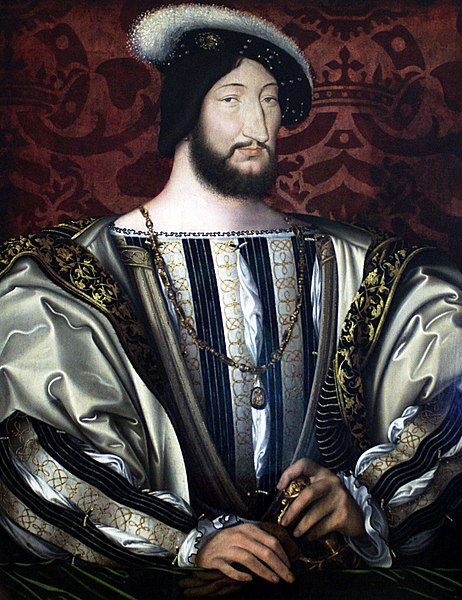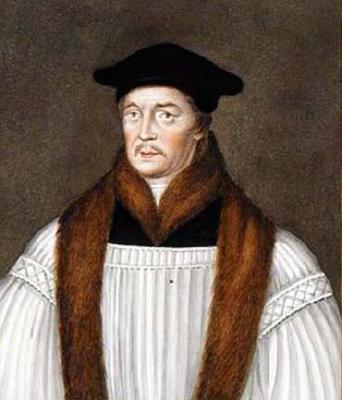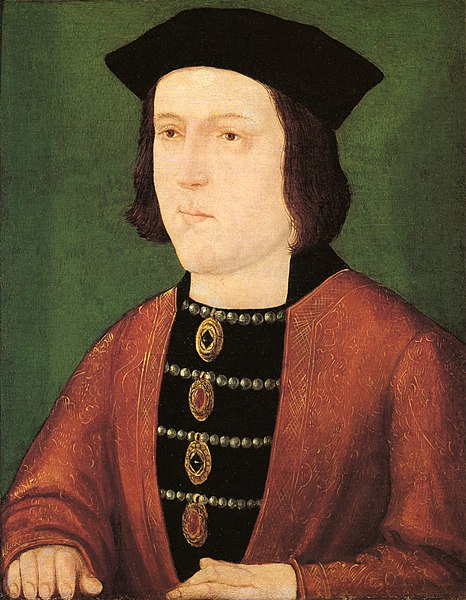 |
| Arthur Plantagenet (C) |
Back Home
In 1514 Arthur was appointed High Sheriff of Hampshire[i] and made captain of the Vice-Admiral's[ii] ship Trinity Sovereign[iii]. At some point Henry made his uncle keeper of the royal forests of Clarendon and Bere.
Meanwhile, having discovered the perfidy of his allies, Henry had come to peace terms with Louis XII and an agreement was made whereby Louis would marry Henry’s sister Mary[iv]. The marriage took place on 9th October 1514 in Abbeville; Mary had Anne and Mary Boleyn among her attendants; their father Thomas was one of Henry’s favourite courtiers.
Within three months Mary’s elderly husband was dead and Henry was not best pleased when his sister returned home after a secret betrothal to his best friend Charles Brandon, Duke of Suffolk who had distinguished himself at the sieges of Thérouanne and Tournai. Henry had agreed to Mary remarrying the man of her choice once Louis was dead, if Mary agreed to marry the French king.
"If she survived him [Louis],
she should marry whom she liked."[v]
He was now most upset that his sister had taken him at his word.
Brandon had been betrothed to marry his ward Elizabeth Grey[vi], Viscountess Lisle, Elizabeth Plantagenet’s niece. In anticipation of the marriage Brandon had been made Viscount Lisle; now Henry made him surrender his ward and the title in favour of Katherine Plantagenet, Countess of Devon and Arthur’s half-sister. Katherine married Elizabeth Lisle to her son Henry Courtenay but Elizabeth died before the marriage could be consummated. In 1519 Arthur and his wife Elizabeth Grey, took possession of the lands that had belonged to her father and Elizabeth became Baroness Lisle in her own right.
The Field of the Cloth of Gold
 |
| Francois I |
‘700 conger eels, 2,014 sheep, 26 dozen heron and 4
bushels of mustard.…[and] £1.0.10d[ix] worth
of cream for the King’s cakes.’[x]
Wolsey was busy on the diplomatic front trying to arrange a marriage between François and Princess Mary[xi]. He was also attempting to confront the vexed question of arrears of monies due under the terms of the Treaty of Étaples and trying to reconcile François and the emperor Charles[xii], who was hovering just over the border.
The attempt failed and Charles had to wait until François had departed before Henry invited Charles to visit him in Calais on 10th July. Despite the previous weeks’ jollification French worries were not alleviated by the obvious amity between the English and the Holy Roman Emperor. Charles gave Wolsey a pension of 7,000 ducats[xiii] and promised his aid when the papal throne became vacant.
On 25 April 1523 Arthur was created Viscount Lisle and in 1524 was made a Knight of the Garter. He was also to be selected to be a Privy Councillor. In 1525 Arthur was made Vice-Admiral of England and he remained Vice-Admiral until 1533 when he was appointed to a new post in Calais.
Marriage
Number Two
 |
| Honor Grenville |
Some time after Elizabeth
died (date unknown), in 1529 the 67 year old Arthur[xiv] married Honor
Grenville, widow of Sir John Basset, thirty
years his junior. It was claimed that Honour was ‘of cold complexion’. She had a delicate skin and colouring. Her
friend Sister Antoinette de Saveuses, a nun at a convent in Dunkirk, mentioned Honor’s ‘tender and delicate person’. Sir
John Wallop, Lieutenant of Calais
Castle was an admirer of Honor’s charms.
Arthur and Honor had a close
and loving relationship. On one of the few occasions they were apart the
uxorious Arthur wrote to his wife;
‘I had never better health, but I think so
much on you I cannot sleep i’ the night.When I think on you, in two hours after
there was never child who thought so long for his nurse as I do for you.’[xv]
Honor was loving towards
Arthur; on an occasion in 1538 when she travelled to England she wrote;
‘Mine own sweet heart, This shall be to
advertise to you that I have had a goodly and fair passage….I thank God that I
was once sick in all the way; and after that I was merry and well, and should
have been merrier if I had been coming towards you, or if you had been with
me.’[xvi]
Like Arthur, Honor enjoyed ‘pastime with good company,’ good food,
entertainment and was at ease with people of all social rank. She was an
energetic correspondent, keeping in touch with her children and the Lisle’s man
of business, along with friends and anyone who might assist the Lisle’s at
court. Honor was also claimed to be sharp and hasty.
 |
| Reading Abbey |
Honor had seven children,
who were to claim much attention from their stepfather. By 1532 Arthur had
purchased John Basset's[xvii] wardship from John
Worth of Compton Pole[xviii], Devon, Sewer to the King’s Chamber. John was
educated at Reading Abbey,
where the Abbot was Hugh Cook, a
friend of Arthur’s. Arthur married John to his daughter Frances on 19th
February 1538 (all the bridal finery being procured on credit, due to Arthur’s
perennial financial problems), providing her with a wealthy husband.
The middle son George was placed at Hyde
Abbey where the Abbot, John
Salcot kept an eye on him. George was
then sent to St Omer
before being sent to live with Sir
Francis Bryan[xix], a very close friend of Arthur’s[xx].
A
Precocious Little Horror
 |
| College of Sorbonne 1550 |
Honor’s third son James was apparently ‘a
precocious little horror’ who wrapped his mother around his little finger.
In the summer of 1533 James was sent to Reading Abbey and in August 1535 after
a stay in Calais with his mother, James went to the Collège de Calvi[xxi] in Paris.
Once in Paris James fell in
with a group of English scholars, including James Bekynsaw, studying at the College of Sorbonne and determined that he would do better at the Collège de Navarre where he
would meet the sons of the nobility. In this, as in most matters, James got his
way.
 |
| Bishop Gardiner |
As the youngest son James
was destined for holy orders and was ordained as a minor cleric and given the
income from a prebend’s
living in Cornwall. James was sent to live in the household of Bishop Gardiner, but he was
viewed as;
Honor’s daughters were Philippa,
Katherine[xxiv], Anne who attracted the king’s attention and Mary,
acclaimed as a beauty. All children of the various marriages were regarded as
one family; Lisle was addressed as ‘my
lord my father’ by Basset and Plantagenet children alike. Honor looked out
for advancement for all the extended family. Anne and Mary Basset were placed
in noble French households once the family had moved to France.
Bibliography
The Lisle
Letters – Muriel St Clare Byrne, Penguin Books 1985
Cardinal
Wolsey – Mandell Creighton, MacMillan & Co 1891
The Royal
Bastards of Medieval England – Chris Given-Wilson and Alice Curteis, Barnes and
Noble Inc. 1984
The Ebbs and
Flows of Fortune – David M Head, University of Georgia Press 2009
Thomas
Cromwell – Robert Hutchinson, Phoenix 2008
Henry VIII –
Robert Lacey, Weidenfeld & Nicholson and Book Club Associates 1972
The Earlier
Tudors – JD Mackie, Oxford University Press 1992
Thomas More
– Richard Marius, Weidenfeld & Nicholson 1993
The Tudor
Navy – Arthur Nelson, Conway Maritime Press 2001
Six Wives –
David Starkey, Chatto & Windus 2003
The Six
Wives of Henry VIII – Alison Weir, Pimlico 1992
[i] Possibly because of his close connections to the area
[vi]
Daughter of John Grey 2nd Viscount Lisle and cousin of Arthur’s
wife, daughter of Edward
Grey 1st Viscount Lisle
[vii]
Arthur was one of the gentlemen representing Hampshire
[viii]
Temporary but extremely luxurious pavilions were erected for both monarchs
[ix]
In 2014
the relative: real price of that
commodity is £596.60 labour value of that
commodity is £5,597.00 income value of that
commodity is £19,360.00 www.measuringworth.com
[x]
Henry VIII - Lacey
[xi]
Four years old
[xii]
Maximilian died in 1519
[xiii]
In 2014
the relative: historic standard of living value of that income or wealth is £4,008,000.00 economic status value of that income or wealth is £130,000,000.00 economic power value of that income or wealth is £1,981,000,000.00 www.measuringworth.com
[xiv]
By Byrne’s calculations
[xv]
The Lyle Letters – Byrne
[xvi]
Ibid
[xvii]
The oldest of Honor’s sons
[xviii]
A cousin of the Bassett family
[xix]
One of Anne Boleyn’s cousins; Bryan
was Chief Gentleman of the Privy Chamber and Lord Chief Justice of Ireland
[xx]
George eventually married and went to live in Cornwall and became an MP
[xxi]
At this time used for primary education of children, teaching them the
rudiments of grammar
[xxii]
James was a strong proponent of the
Catholic faith and eventually moved into Mary Tudor’s household when she was
queen. He married Thomas More’s granddaughter Mary Roper and was allegedly
involved in an assassination attempt on Princess Elizabeth
[xxiii]
The Lisle Letters - Byrne




